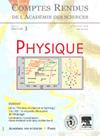蒙格真的解释了低等海市蜃楼吗?
IF 1.2
4区 物理与天体物理
Q3 ASTRONOMY & ASTROPHYSICS
引用次数: 3
摘要
. 加斯帕德·蒙日(Gaspard Monge)因1798年在埃及观察到海市蜃楼而受到了不应有的赞誉。他没有发现劣质的海市蜃楼;1687年以前,水手们就知道了它们,而海市蜃楼这个词在1753年才进入法国文学。蒙格对它们的“全面反思”解释存在严重缺陷;它已经被格鲁伯和贝本文章由计算机程序翻译,如有差异,请以英文原文为准。
Did Monge really explain inferior mirages?
. Gaspard Monge has received undue credit for his observations of mirages in 1798 in Egypt. He did not discover inferior mirages; they were known to sailors before 1687, and the term mirage had entered the French literature in 1753. Monge’s “total reflection” explanation for them was seriously flawed; it had already been considered and rejected by Gruber and by Büsch, and was promptly criticized by others. Yet he continues to be given credit for the first scientific explanation of mirages; and his false total-reflection mechanism survives today in some textbooks. Apparently this is due to its superficial simplicity, which appeals to novices.
求助全文
通过发布文献求助,成功后即可免费获取论文全文。
去求助
来源期刊

Comptes Rendus Physique
物理-天文与天体物理
CiteScore
2.80
自引率
0.00%
发文量
13
审稿时长
17.2 weeks
期刊介绍:
The Comptes Rendus - Physique are an open acess and peer-reviewed electronic scientific journal publishing original research article. It is one of seven journals published by the Académie des sciences.
Its objective is to enable researchers to quickly share their work with the international scientific community.
The Comptes Rendus - Physique also publish journal articles, thematic issues and articles on the history of the Académie des sciences and its current scientific activity.
From 2020 onwards, the journal''s policy is based on a diamond open access model: no fees are charged to authors to publish or to readers to access articles. Thus, articles are accessible immediately, free of charge and permanently after publication.
The Comptes Rendus - Physique (8 issues per year) cover all fields of physics and astrophysics and propose dossiers. Thanks to this formula, readers of physics and astrophysics will find, in each issue, the presentation of a subject in particularly rapid development. The authors are chosen from among the most active researchers in the field and each file is coordinated by a guest editor, ensuring that the most recent and significant results are taken into account. In order to preserve the historical purpose of the Comptes Rendus, these issues also leave room for the usual notes and clarifications. The articles are written mainly in English.
 求助内容:
求助内容: 应助结果提醒方式:
应助结果提醒方式:


